-
Creative Aging: Why Arts Educators Need to Engage Older Learners Now
You’re never too old to learn something new, and it’s never too late to embrace your creativity. That’s the idea behind creative aging: art programs for older adults that enhance their quality of life through music, visual arts, and other activities.
If you’re an arts organization, library, community center, or anyone offering educational programs to the community and you are not serving older adult learners, you’re missing a huge opportunity.
By 2030, older adults (aged 55+) will be the dominant age demographic in the United States. By 2034, older adults will outnumber children under age 18 for the first time in U.S. history, according to Census Bureau projections.
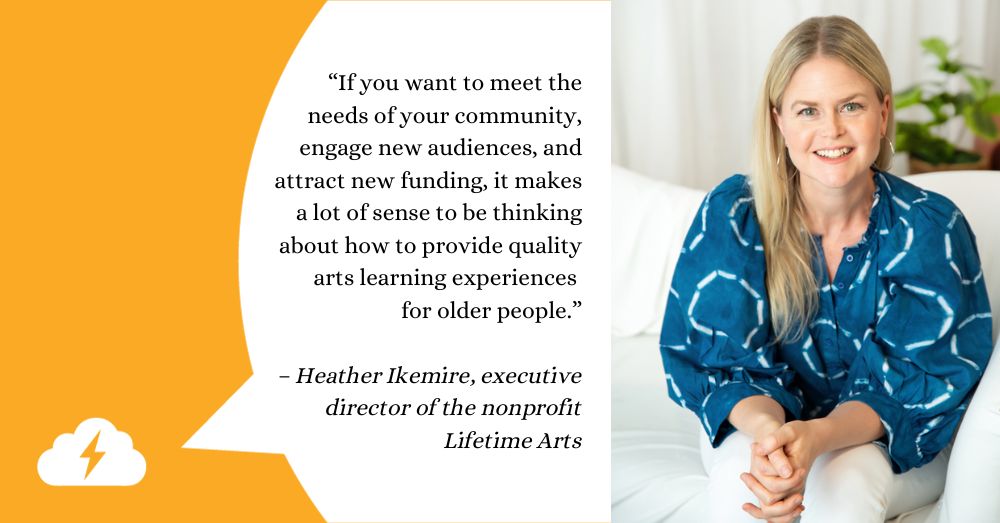
“If you want to meet the needs of your community, if you want to engage new audiences and attract new funding, it makes a lot of sense to be thinking about how to provide quality arts learning experiences for older people,” said Heather Ikemire, executive director of the nonprofit arts service organization Lifetime Arts.
But first, there are a few things you should know about reaching an audience of older learners.
What Is Creative Aging?
In case you haven’t heard it before, the term “creative aging” describes the use of arts and cultural activities to improve the quality of life for older people, Ikemire explained. The field encompasses many different approaches and is practiced all over the world. Lifetime Arts recently hosted the 2023 International Creative Aging Summit, which had 400 participants from 26 countries.
“While the approaches to the work vary, in its broadest sense it’s recognizing the power of creative expression—engaging older people in activities centered on creative and social engagement, and the power that has in terms of supporting quality of life, the process of aging well, and also transforming cultural mindsets around what it means to age,” said Ikemire.
Creative aging programming can happen in multiple disciplines (music, film, visual art), in multiple spaces (libraries, museums, senior centers), and remotely or in person.
Creative aging programming can happen in multiple disciplines, including music, film, theater, and visual arts, and in multiple spaces, such as libraries, museums, veterans homes, and more. Classes for older adults can happen remotely as well as in person, and can be free, paid, or subsidized programs.
Key Characteristics of Older Adult Learners
Older people are living longer and seeking meaningful ways to connect and continue to learn skills. But a watercolor class for adults aged 55+ should not be identical to a class for school-aged students. There are several factors that differentiate older learners from their younger counterparts:
Adult learners are autonomous and self-directed. “They vote with their feet,” as Ikemire put it. Educational programming has to speak to them and their interests or they’ll go find something else. The best way to offer programs they want? Ask them! “It’s incredibly important to listen to the older adults in your community,” Ikemire advises arts organizations.
Older people are goal-oriented. They’re not just looking for a hobby or something to fill the time. They want to learn and develop skills. The creative aging model used by Lifetime Arts focuses on professionally led instructional arts programming designed to build artistic skills over time. Participants have an opportunity to practice something and then keep applying it so they can see their skills improve.
They are seeking connection. There’s a reason creative arts programming typically takes place over a period of many weeks rather than one-time drop-in sessions. “There is evidence that shows that building social connection over time can actually lead to significant physical and mental health benefits for older people,” said Ikemire. Art classes for the elderly help to reduce social isolation and loneliness, among other advantages.
In a recent survey, 42% of U.S. adults aged 55+ said they were seeking more social connection in their lives.
A recent report on aging surveyed more than 28,000 U.S. adults aged 55+ and found that 42% said they were seeking more social connection in their lives. That percentage increased with age.
They may have barriers to participation. These may include physical limitations, such as hearing or vision impairments or an inability to stand for long periods. Transportation could be an issue, or time of day if they don’t drive at night. Or, there might be another popular class in the community that meets at the same time as yours.
Seniors are not necessarily tech-averse. If you’re offering an online class, or even online registration for an in-person class, you might assume that rules out older learners. That’s not necessarily the case. While some seniors may be unfamiliar with technology, many are more tech-savvy than ever, thanks to the pandemic. That said, there are some best practices for working with seniors that we cover in our post, 6 Tips for Teaching Tech to Older Learners.
Opportunities for New Revenue Streams
Offering arts programs for seniors not only benefits older learners in a community, but also can boost the bottom lines of the education programs. “It can be a really wonderful earned revenue stream for some organizations,” said Ikemire.
Many arts centers, museums, and theaters are empty during the day. This is especially true for an arts organization that has primarily been serving younger people with weekend classes and afterschool programs. Welcoming older learners into your space during daytime hours is a good way to bring in new audiences.
“When you see creative arts programming in action, it’s joyful. It’s incredibly powerful.” – Ikemire
Ultimately, these programs thrive when there’s institutional buy-in. A big part of making that happen is seeing these programs in action. Invite your staff, your board members, or other stakeholders to see creative arts programming in action.
“When you see it, it’s joyful. You get it right away. It’s incredibly powerful,” said Ikemire. “And there are incredible opportunities to grow audiences, to increase your budget, to find the funders for your work, and also to spark intergenerational connections between young people and older people.”
Examples of Successful Creative Aging Programs
When done right, arts programming for seniors can boost revenue and student loyalty. Here are a couple examples of successful programs for older learners.

Rumriver Art Center, Anoka, MN. Photo credit: Larry Weinberg
Rumriver Art Center
Previously only providing youth classes, Rumriver Art Center in Minnesota decided to expand their program offerings to include arts education opportunities for adults 55+. These programs attracted so much interest that they had to add more classes and staff.
Over the course of two years, the center’s creative aging programming budget increased from zero to over 25% of their annual budget. Many of the students later became teachers, volunteers, and even employees after attending classes.
Forever Learning Institute
Another example of a thriving education program dedicated solely to older adults is the Forever Learning Institute (FLI) in South Bend, Indiana. For 45 years, FLI has engaged older learners through a robust catalog of enrichment classes covering all sorts of topics including dance, technology, literature, and foreign languages. The classes are taught by an all-volunteer faculty.
FLI is home to the Silvertones, a musical glee club for ages 50+, that performs at various community locations throughout the year, as well as the Solid Silver Dancers, who learn and perform dances from the 40s, 50s, 60s, disco, Broadway, and more. The course description for that class describes it as “a dance workout that is easy on the knees and made especially for us seniors. But still fun and sassy!”
It’s worth noting that courses that incorporate movement are especially important for older learners. Numerous medical studies have shown that the more physically active you are as you age, the healthier you’ll be for longer.
Creative Aging Resources for Arts Organizations
There are numerous resources for organizations interested in learning about and implementing creative aging programming, many of them free. The best place to start is Lifetime Arts’ website, The Creative Aging Resource. The site includes articles, case studies, presentations, and research on a wide range of topics related to arts education for older populations.
Lifetime Arts also offers Creative Aging Foundations On Demand, a free, self-paced online course designed for institutions and individuals seeking to run arts programming for older adults. The course includes instructional videos, practical program design principles, and information on developing partnerships with other community organizations serving older adults.
“Creativity is a human right for all of us throughout our lifespans.” – Ikemire
“This is a time for us as mission-driven organizations to think about how we can provide programming that can really enable all people, including older adults, to age well, to age in community, and to still contribute,” said Ikemire. “Creativity is a human right for all of us throughout our lifespans.”
CourseStorm counts a number of community education and arts organizations among our customers. Our mission is to streamline access to education to empower personal growth. Learn more about us and get in touch today to see how we can help your organization.
-
6 Easy SEO Tricks to Make Course Listings More Visible on Google
The secret to search engine optimization is that there is no secret. But a few easy SEO tricks can make your course listings more visible on Google. Not only will they help students find your course pages, they’ll also make those pages more user friendly and attractive for learners.
You might be wondering why we’re focusing on Google specifically. The answer is pretty simple — Google searches account for more than 85% of the global search market share. Optimizing for Google search is a high-impact way to increase the visibility of your courses across the internet.
We’re not going to tell you to hire a pricey SEO firm or rebuild your entire website from scratch. Instead, we offer real changes you can make today to improve your SEO performance. Because when it comes to search engine optimization, small changes can make a big difference.
What Is Search Engine Optimization?
Let’s start by defining our terms. Search engine optimization is the content, formatting, programming, and hosting decisions that help you show up first in search engine results.
For the purposes of this guide, we’re going to talk mostly about on-page SEO. That is, the changes you can make to content on individual pages of your website to improve your ranking. We’re not going to get into programming and web development. Although, if you really want to up your SEO game, your web developer probably has some suggestions.
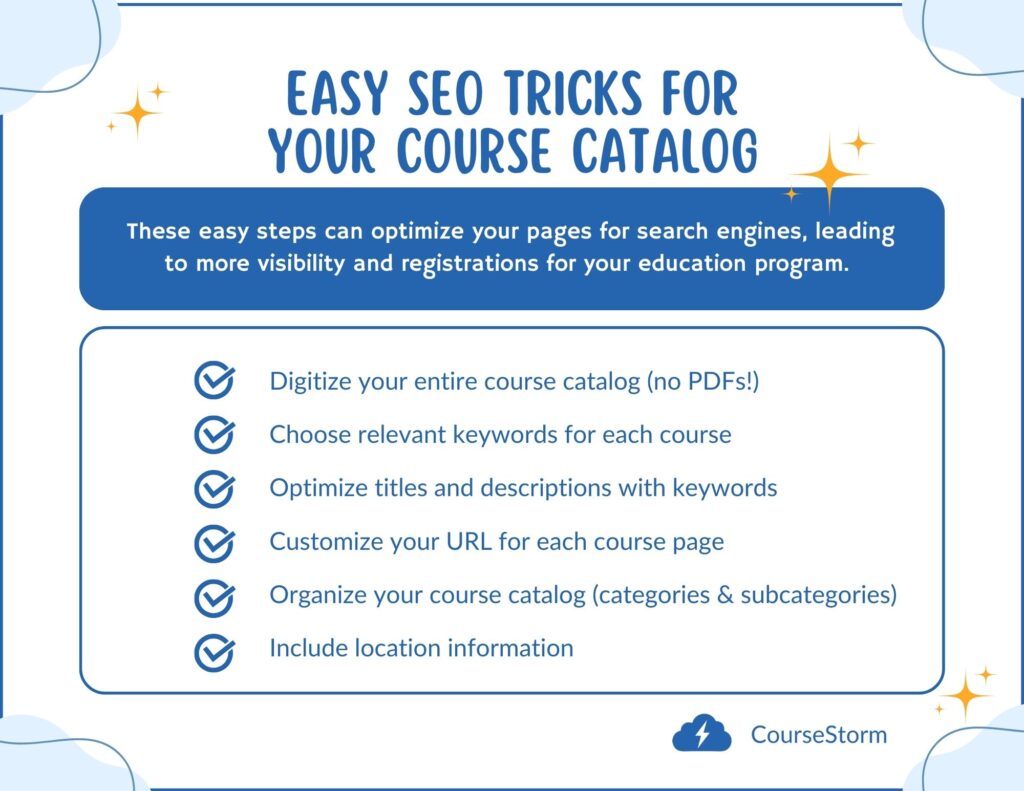
Easy SEO Tricks to Quickly Make Course Listings More Visible
These easy SEO tricks can apply to any page on your website, but we’re talking about how they can help with course listings because increased course page visibility often leads to more registrations for your program.
1. Digitize Your Entire Course Guide
Printed course guides are still a powerful tool. Sending them directly to potential students can help interest them in your programs, but a print catalog can’t improve your SEO. Some programs try to get away with uploading their course catalog as a PDF on their website, but that won’t help either.
Uploading your course catalog as a PDF does not help SEO since search engines can’t read the contents of PDF files.
First, search engines can’t read the contents of PDF files. When your course catalog is a PDF, you miss multiple opportunities to rank in search for course types and individual classes. Second, it creates an accessibility barrier. Some people are anxious about downloading files that could potentially infect their computers. Others don’t have the bandwidth for big downloads.
Worse, if someone is visually impaired, their assistive tools may not be able to read all PDFs.
When people can’t read your content, they’ll spend less time on your site, which means Google will assume you were unable to meet the user’s needs. The search engine will be less likely to show your content in future searches.
So, putting your course catalog online is good for potential students and for SEO. Without this step, none of our other easy SEO tricks really matter.
2. Choose Keywords That Fit Each Course
Keywords are a core element of search engine optimization. Search engines look for keywords to tell them what a page is about. If the keywords on your page match the ones a potential student typed into their search engine, you’re more likely to rank. Keep in mind that the most powerful keywords aren’t individual words at all. They’re keyphrases. For the blog post you’re reading now the phrase “easy SEO tricks” was one of our keywords.
The most powerful keywords aren’t individual words, they’re keyphrases. Aim for at least 3 per page.
For each page of your course guide, you should have a minimum of around three keywords. One, the primary keyword, should tell visitors the topic of your course. You can mix in a few secondary keywords to add context.
For example, if your keyword is “Beginners Acting Class for Kids,” you might include phrases like:
- Drama class
- Acting training
- After-school activities
- Improve public speaking
You can use Google Trends or other keyword research tools to find the right words.
3. Optimize Titles and Descriptions
The most powerful place to include keywords is in your title. Let’s say you have a course that helps behavioral health professionals get certified. Your title should probably include phrases like Behavioral Health Professional Certification Training or Certification Training for Behavioral Health Professionals.
Your secondary keywords can show up in your description. Don’t get carried away here. In the early days of SEO, the more you used a keyword, the better you ranked. Now, it’s all about context.
Your course description should be interesting and informative. Any keywords it uses should be grammatically correct and make sense in context. They should help the visitor understand what the class is about and whether it’s the right choice for them.
4. Customize Your URL for Each Course Listing
This is an easy SEO trick that many people miss. Every page in your course guide has a unique web address. It probably looks something like this: https://coursestorm.yourprogram.org/course/name-of-course/
Make sure that the slug, or URL, for each course page contains your keywords.
The part we’re interested in for SEO purposes is the text between the last two backslashes. This is known as the slug, and it’s a unique identifier for your page. You want to make sure that the slug includes the keywords for your course. So, if you have a course on How to Draw Animals your slug should be something like /how-to-draw-animals/.
Here’s what to avoid when choosing a slug:
- Don’t use an internal course number. /290340u57/ might make sense to you, but it doesn’t tell Google anything about your course
- Keep it short. /how-to-draw-cats-dogs-chickens-pigs-with-artist-sarah-smith/ is too much and misses the keyphrase
- Use real words and recognizable phrases, i.e. don’t shorten how to draw animals to /hw-to-drw-anmls/
Most website content management software includes an option to customize your slug. Take the extra moment to do this and you’ll instantly improve SEO.
5. Organize Your Course Catalog in a Meaningful Way
Google doesn’t just look at individual pages. It also considers how those pages fit together. This is another case where improving SEO also improves the user experience. When you organize your course content in logical ways, both Google and your potential learners can easily find what they’re looking for.
Organize your course guide into logical categories and subcategories. Categories might include broad topics like:
- Career Development
- Personal Enrichment
- Business and Skills Training
- High School Completion
- Technology
- Summer Camps
- Health and Fitness
Subcategories are more focused but still encompass multiple classes. So under Personal Enrichment you may have subcategories like:
- Arts and Crafts
- Cooking
- Outdoor Experiences
- Personal Finance
Try to choose categories and subcategories that your average student (or their parent) might search for.
6. Include Location Information
Mentioning the city and state where your class is located can make your listing more likely to rank for “near me” searches. So if someone types in “personal finance classes near me” your course listing is more likely to pop up in their search.
Skip this step, and you could be left off the list. It’s probably not enough to include the location of your organization on the contact us page. Make sure it appears on every course listing.
Think Beyond Easy SEO Tricks to Keep Improving
The easy SEO tricks we’ve shared here will get you started. They’re a quick way to improve user experience and get seen on Google. But they’re just the beginning. Keep in mind that SEO is always evolving. What works now may not be a best practice in three years. Watch the headlines to make sure you never miss an update.
CourseStorm can help you create a user-friendly, search engine optimized course catalog.
Our simple course registration software helps you stay organized, lets you customize your URL, and features location information for every class. For more tips on reaching more students, read our post on course catalog examples that boost enrollment.
-
9 Key Elements of a Course Catalog: Examples That Boost Enrollment
Building a quality course catalog can help you convince more students to register. The most effective course listings are more than a simple list. They combine all of the information students need to know to make an informed decision about your courses.
We see a lot of course guides in our work with community and arts education programs. Among the hundreds we’ve seen, a few stand out as strong course catalog examples that other programs could emulate. You can use these examples as a model as you build your own course listings and to avoid common pitfalls. We’ll even break down each one so you can see what makes them effective.
What Is a Course Catalog for?
You may think that a course catalog is a list of classes offered by your program or organization. What people sometimes forget is that a quality course catalog is also a marketing tool. Students use it to decide which classes to take and whether those classes are worth their time and money.
To be effective, your course catalog must capture the eye and the imagination of your potential students. It needs to convince them to register right now.
Potential students who browse a course catalog are looking for answers to two important questions:
- What will this class teach me?
- Is the value of this class worth my investment of time and money?
Many programs struggle because they stop after answering question one. They tell students about subject matter and learning outcomes, but fail to explain why those outcomes matter. As a result, students know what the class is about, but may not see the true value in the experience.
An effective course catalog convinces students of the value of each class. It uses every course title, description, and image to show students what they can get by taking the course.
9 Parts of an Effective Course Catalog, With Examples
An effective course catalog includes 9 parts. Each one helps the student gather information about the courses offered.
- Categories
- Subcategories
- Class names
- Class descriptions
- Images
- Instructor information
- Place and time
- Pricing
- Registration link
Below, the course catalog example from San Juan College Community Enrichment shows all 9 parts in action.
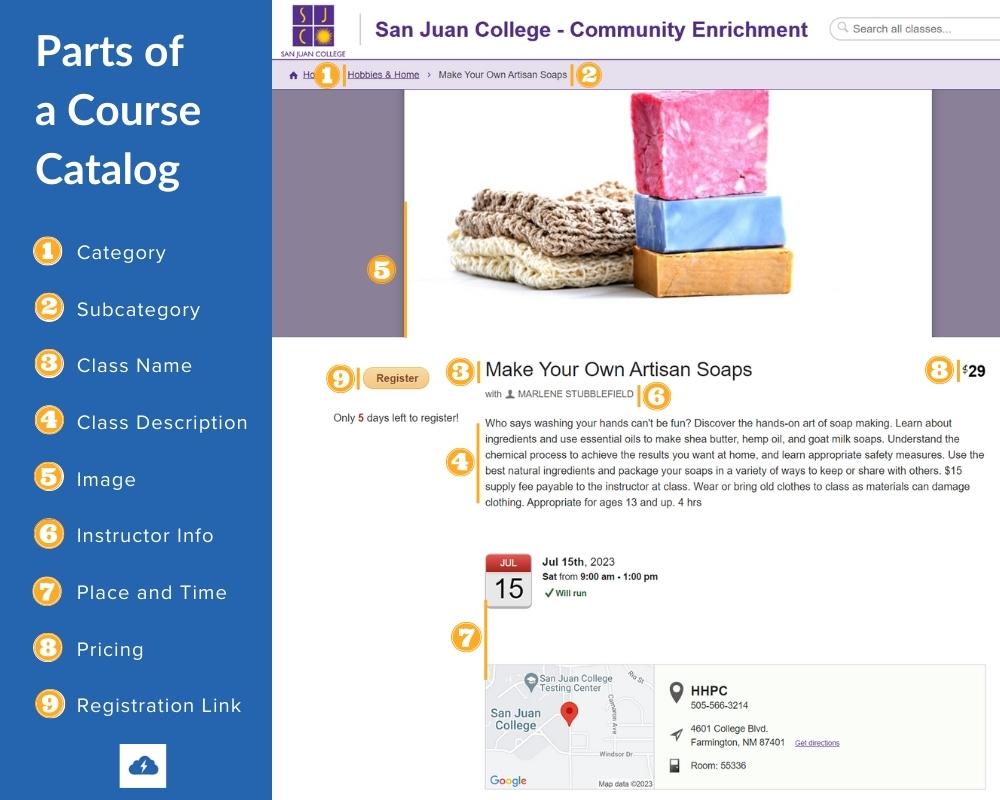
1. Categories: What Is This Course About?
Categories help to group similar kinds of classes and make it easy for people to find the classes they’re looking for. Seek a balance between overly generic and too specific. The goal is to logically group clusters of related classes.
Some categories that are broad, yet specific enough to be useful may include:
- Kids classes
- Workforce development
- Fitness
- Finance
- Music and dance
- Arts and crafts
- Computer skills
- Cooking
For example, the category “Cooking” is precise. Someone can easily imagine the kinds of classes that might fit into that category. It’s also broad enough to include several different classes. Something like “French Cuisine” may be too specific, unless you run a cooking school.
2. Subcategories Make Navigation Easier
Subcategories can break down big topics into more specific focus areas. This helps students find the classes they are looking for by guiding them through your course catalog.
For example, you may have 30 classes in workforce development that focus on 5 or 6 subtopics. Categories can help students find the courses that are most relevant to them.
Some example subcategories for workforce development might be:
- Computers & technology
- Healthcare & medical
- Entrepreneurship
- Financial literacy
- Skilled trades
3. Class Names Tell Students What to Expect
Effective class names tell students what the class is about. When writing class names, aim for clear description over cleverness. Here are a few examples of real class names that work:
- Digital Photography: Capturing the Right Shot
- Write From the Heart for Fun and Profit
- Five Unexpected Books Every Classical Educator Should Read: Free Webinar
- Websites That Work: Converting Web Visitors Into Customers
These class names work because they’re clear and include keywords that search engines can find. Some also include extra details about format or cost.
Of course, if you can be clear and clever, that’s even better. One CourseStorm customer put this idea into action for her “Learn to Crochet” class. Last year, the class was canceled due to lack of registrations. Instead of overhauling the class, she changed the name. This year, she quickly filled the class “Too Legit to Knit: Crochet Instead.”
Pro Tip: If you run the same class every season, keep the name the same in each version of the catalog. (Unless you’re hoping to revitalize a lagging class!) This helps students recognize classes they’ve already taken and spot new ones on their preferred topics.
4. Descriptions With Real Course Catalog Examples
Course descriptions tell students what they’ll learn and why they should take a course. Focus on the real effect the course could have on their life. Writing a quality course description takes some effort, but the results are worth it.
Here’s an example of a real course description from The Training Place:
“If there’s one thing guaranteed in life, it is change. The way in which we navigate unanticipated change and stressful experiences will have a direct impact on our mind and body in subtle and not so subtle ways.
You will be introduced to the Change RHYTHM model, explore the tone of your inner narrative, self-assess your relationship and mindset towards a recent change event, and define a set of unique resilience rituals that will enable you to adapt to and evolve through the change and maintain forward momentum in the new normal that follows.”
This course description works because it:
- Speaks to a real need the student has — dealing with change.
- Explains exactly what students will learn.
- Includes a clear outcome: “adapt to and evolve through the change and maintain forward momentum in the new normal that follows.”
Pro Tip: If you realize you need to share more information than can comfortably fit in a course description, consider linking to a course fact sheet or FAQ attachment.
Keywords: the Hidden Element of a Course Catalog
Using key search terms in your course titles and descriptions makes them more discoverable to search engines. That helps your students find what they’re looking for.
You can do some basic keyword research using a tool like Semrush or Moz. Then, include those keywords in your course descriptions. Aim for a good mix of the two main types of keywords:
- short-tail keywords are short and broad, such as “classes for adults” or “First Aid class”
- long-tail keywords are longer and more specific, like “sustainable papermaking course for adults” or “Lego robot workshop for teens”
Include both so search engines can see what your course is really about and who it’s for.
5. Images Increase Engagement
Images make your course listings seem more inviting. The best option is to use real photos from your courses. If that’s not possible, high-quality stock images or custom graphics can fill the gap.
Look for images that are easy to understand at a glance. Smiling faces and bright colors tend to be most engaging. Remember to use images that include all the types of people who might take your classes.
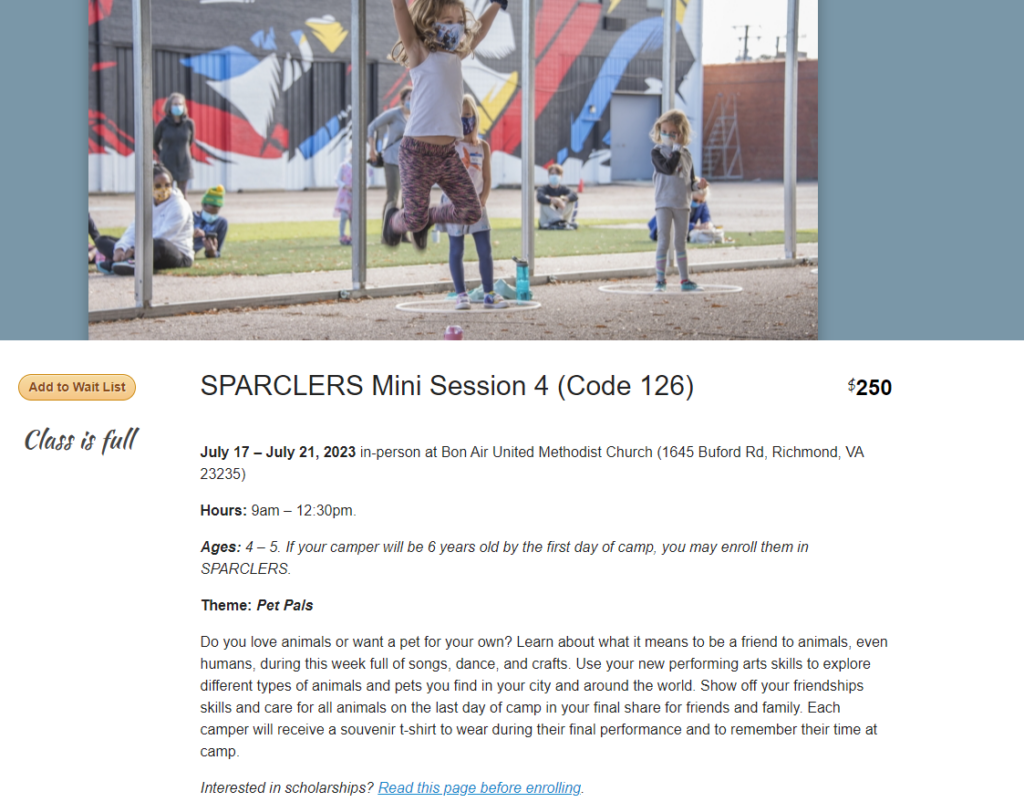
6. Instructor Information Boosts Student Confidence
Information about the instructor can provide a compelling reason to take a class. Include a paragraph about the instructor and their background, or link to their bio elsewhere on your site.
7. Place and Time Help Orient Students
Include information about when and where the class will run, so students can tell if it fits their schedule. Remember to mention whether a class is online or in-person.
8. Pricing Information Is Essential
Include clear pricing information for every class. Make sure you’re accurately portraying the whole cost of the program. Some students may love to take an art class for $300, but when they find out they have to spend another $300 to buy their own supplies, the course no longer fits their budget. It will save both your time and theirs to be forthright about pricing.
For big-ticket courses, consider offering payment plans to make them more accessible. Being open about pricing helps build trust and gives students the information they need to make an informed decision.
9. Registration Links Let Students Act Now
Every class listing should include a button or link where students can register right away. This makes it easy for someone to act while interest is high.
Using online registration software with payment processing streamlines enrollment for students and for you. After registering online, all they have left to do is show up for class!
Avoid This Major Course Catalog Mistake!
Some programs can get all 9 parts right and still not see the number of registrations they were hoping for. Why? Because they’re requiring an account before letting someone view their course catalog.
We’ve all had the experience of trying to read an online article only to be informed that we need to create an account first. Not only does this interrupt the natural flow for the user, but it also makes them mistrustful. They wonder, “Do you even want me to read your content, or do you just want my contact information so you can bombard my inbox with sales emails?”
Your class offerings aren’t confidential information—in fact, the more people who know about them, the better! Making your course catalog accessible to all gives students the chance to discover a class that’s a perfect fit for them.
Quick fix: Share your course catalog openly and freely. Make sure the link routes visitors directly to the catalog without a login.
Course Catalog Examples: How It All Fits Together
A well-organized course catalog is inviting. Whatever organizational structure you choose to guide your layout should be consistent throughout. For example, you may choose to list your classes alphabetically, or you may choose to list them based on when they run, or you may choose to list them by type category.
However you organize, make sure the course catalog is searchable. Bonus points if you can allow students to adjust how courses are sorted so they can view them by date, price, or alphabetically by title.
CourseStorm offers everything you need to build your own course catalog like the examples shared here. To learn more, start your free trial or contact us today.
-
Low-Cost Course Promotion: How to Advertise a Class on a Budget
When you think about how to advertise a class, paid ads might be the first idea that comes to mind. That makes sense, since paid advertising absolutely can help with course promotion. There’s just one major drawback to this strategy—the cost.
Most education programs don’t have massive budgets to work with. They need affordable, maybe even free, ways to promote classes. Fortunately, it is possible to advertise courses without spending a ton of money. To help you do that, we’re sharing some of the ideas we’ve seen CourseStorm customers use to promote their classes and programs.
Course Promotion Starts With a Clear Message
You’ll use the same basic information in many different ways to advertise your course. So the first step is to collect all of that information. You’ll want a clear and compelling course description, some relevant images, and a link that people can use to sign up. All of this should be easily found in your course catalog.
Set up an easy website link
The benefits of straightforward website navigation can’t be overstated! When folks visit your website, make sure it’s easy to find your newest courses.
Don’t assume interested students will dig through an entire course catalog to find the class they’re interested in. Make sure the link you share on social media or other third-party sites brings the user directly to the sign-up page for that specific course.
With this information in hand, you’re ready to start advertising your course.
Ways to Advertise Courses for Free
1. Send an announcement to your email list
The first step is to prepare an email blast to send to your contacts. Announcing the new class to your existing customers first is good practice, because these are most likely to be people who have taken your courses before.
Include the course description and a registration link. You can also mention that you’re sharing the news with your email list first. People love to feel special and in the know, so an exclusive first look at upcoming courses can help build student loyalty.
Keep in mind that people get a lot of emails. You might want to send the announcement a couple of times over two or three weeks to make sure it gets seen. If you send multiple emails, use different subject lines for each one. You can also personalize email content and subject lines to make messages more appealing.
2. Share on social media
Create an eye-catching social media post to share the news about an upcoming class. If you’re sharing on Facebook or LinkedIn, you can share the link with a short description, and the platform will automatically include your image.
For Instagram, you’ll need to get a little more creative with your social media graphic since you can’t share links directly. Include a link to the course in your bio or as part of your Linktree. Don’t forget to mention the link in your post. See the example below for one way to do that.
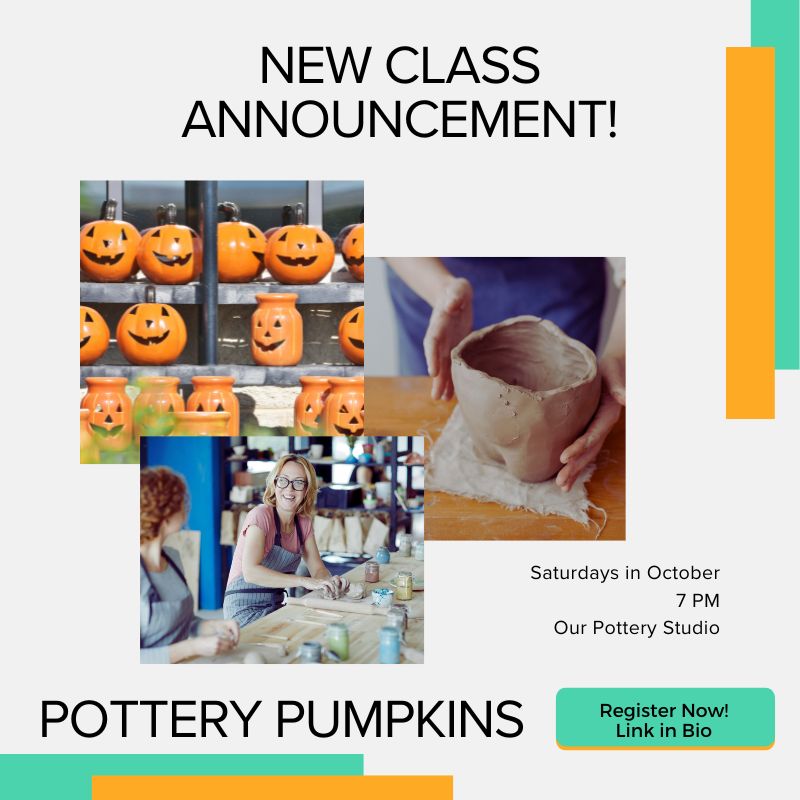
In fact, wherever you post, include a call to action. A call to action is a short, specific statement telling users what action to take when they view your content. Examples of call-to-action statements include:
- Register Now
- Save Your Seat
- Sign Up
- View New Classes
Encourage your staff to share the post on their personal social media pages as well to boost your views. If you’re into social media advertising, you can also “boost” it as a sponsored post.
3. Add a link to your email signature with a call to action
It’s easy to overlook the not-so-humble email signature! They’re relatively easy to change and that makes them an excellent place to share major announcements.
If you’re announcing a new class, edit your email signature to include a button, graphic, or link to the registration page. You can ask everyone in your organization to share the link in their emails as well.
4. Use your voicemail message to alert your audience
Most voicemail programs are easy to update, so big news can be shared in that space too. Be concise and direct listeners to a place they can learn more.
For example, “Registration for our new Adult Dance classes is open now. Visit our website to save your spot.”
5. Get it on a local events calendar
Most local and even regional news outlets have community calendars where you can share your class information. They might be called briefs, upcoming events, or community news. Members of the community can submit short listings for events, workshops, or classes.
Check your local paper or publication to see if they have something like this. If they do, make sure you follow their directions for how to post. Some will ask you to send an email to a specific address. Others offer the option to automatically add your listing using a simple submission form. It’s a quick and easy way to make your classes more visible.
6. Create a Facebook event
Many people use Facebook as a tool to find out what’s going on in their community. Create a Facebook event to get in front of this audience. Make sure you clearly state that registration is required and what the class costs.
Include all of the location and scheduling information. Then link to your registration page so people know how to sign up.

7. Send a press release to appropriate media channels
A press release can help your program spread the news quickly. Write your class announcement following standard press release format, and email it to your media contacts.
If you don’t know anyone at the local news station, visit their website. They should have a page that tells you where and how to submit news. Your local chamber of commerce may also be able to provide you with a media contact list.
If you don’t hear back within a few days, you can send an email to follow up. Keep your email short and polite. Something like this:
Dear Editor’s Name,
I know you get a lot of press releases and there’s a chance mine got lost in the shuffle. We’re offering a new class that can help adults prepare for in-demand tech jobs. It’s a timely topic since the tech job market is growing rapidly. I’ve included the release again below so you don’t have to go digging for it.
Best,
Your NameKeep in mind that making staff and instructors available as sources, and generally being helpful to the press is a long-term investment. When editors and journalists see that you’re a reliable source who provides newsworthy information, they’re more likely to work with you. Keep building these relationships to get your classes the publicity they deserve.
8. Host a live stream
People love live videos! You can share your news with a live video on your favorite social media channel. Don’t overthink it. Here’s an easy recipe for a successful live experience:
- Announce it a few days ahead of time
- Plan for no more than 15 minutes
- Prepare a list of talking points
- Practice beforehand
- Go live!
As an example, here’s how to start a live broadcast on Instagram.
How to Advertise a Class Inexpensively
9. Drop it in the mailbox
If you have mailing addresses for prior students, you can drop a postcard in the mail to announce your new class. Physical mail stands out because it’s less commonly used these days. That means students may be more likely to pay attention to this tactic if it’s used sparingly.
You can target your list by deciding to send it to the people you think will benefit the most. That could be only people who registered in the past year or only those who pay with cash or a check.
The US Postal Service also provides special rates for bulk marketing mail that will allow you to target residents in a particular zip code. They even have discounted rates if your organization is a nonprofit.
Good design is really important for physical mailings. You want people to really look at your postcard, not lump it in with junk mail. Make sure to include a short website link where they can access more information. You might also include a QR code (more on those in a moment).
10. Put up posters using easy-to-access QR codes
Posters are still a great way to announce upcoming classes. They target a local audience and can reach people who aren’t already on your mailing list or following you on social media.
To make it easy for folks on the move to find out more, use a custom QR code that can be scanned with a cellphone camera to share specific information. You can make them for free using an online generator. We like Unitag but Canva also has a built-in QR code app you can access if you’re already using this graphic design software to make posters.
11. Increase engagement with a promo code or discount
A promo code can entice someone to read more or take a chance on a new class. The discount can be limited to meet a specific timeframe, like the first week after the class is announced. Send it out to your email list or print it on your postcard mailing.
You might even offer discount codes as a reward for signing up. Students who register for your new class can get a code that they can use for future classes or share with a friend.
Download the Class Promotion Checklist
Every time you have a new class to promote, you can follow this list. If you can supplement with some paid advertising, great. If not, these tactics should still help fill your classes.
Want a handy checklist version? We created a printable, easy-to-use reference to make remembering where to share even easier for you.
Of course, figuring out how to advertise a class is just the first step. Next you need to make it simple for students to register. That’s where we come in. CourseStorm’s simple online registration and payment solution offers a streamlined class sign-up process for every student.
-
The Benefits of After-School Enrichment Programs
Students are heading back to school. And that means parents are looking for activities to keep their children busy and engaged after the dismissal bell rings. That may be aftercare or afterschool enrichment programs at school or other enrichment activities in the community.
A national survey of 2,000+ K-8 parents and guardians by the nonprofit organization Learning Heroes found that 65% have children enrolled in after-school activities. The most common reason was “to expose children to new experiences, ideas, and perspectives beyond their everyday home and school lives.” Data also show that demand for afterschool enrichment programs has skyrocketed.
This article can help organizations offering afterschool enrichment programs to understand what parents and students are looking for in after school enrichment activities, showcase the benefits of your program, and attract and enroll more students.
What Are Enrichment Programs?
After-school enrichment programs typically focus on fun, games, play, movement, and other activities students may not get to participate in during the school day.
Afterschool enrichment programs typically offer a variety of activities, letting students explore and discover new interests.
Afterschool enrichment programs often provide a range of activities, letting students explore different options and discover new interests. “Furthermore, because after-school programs are sometimes more diverse than school classrooms, with students of different ages and backgrounds, children can build empathy, communication and teamwork skills,” noted US News & World Report.

In fact, building those “soft skills” that are so important in the workplace and in life is one of the key benefits of enrichment programs for all ages.
There are after-school enrichment programs specifically focused on subjects like coding or the arts, such as TRYPS Children’s Theater in Missouri, which offers an arts-based alternative to other afterschool programs for grades K-5. Students participate in “mini plays” and theater games as well as art projects and field trips.
Most after-school enrichment programs are geared toward elementary-age students. However, there are opportunities for middle school and high school students as well. Activities for these ages tend to take the form of afterschool clubs like chess, robotics, or coding. Some community makerspaces may offer enrichment classes or workshops. For older teens, afterschool workforce development programs are an option. And of course, sports and music are always popular after-school activities.
The Top Afterschool Enrichment Classes for Kids
The Learning Heroes report found that 49% of after-school activities are arts, sports, or interest-based programs, and 18% are academic. As for the most popular after-school enrichment activities, US News puts these at the top of the list:
Art. “Art is fundamental to education as a cross-brain experience that involves mind, body, and heart,” said Karen Pittman, co-founder of the nonprofit Forum for Youth Investment. Read more about the positive impact of the arts on health, as well as how to market art classes for kids to the parents who will register them.
Foreign languages. Research shows that language learning is linked to higher academic achievement and can help develop students’ reading abilities. Learning a second language has other benefits, as well. Bilingual children have been shown to demonstrate empathy better than their peers who only speak one language.
Martial arts. In addition to providing physical activity, the martial arts—such as karate, taekwondo, and judo—also teach respect, honor, and discipline. Children who participate in martial arts have shown increased social skills and confidence along with less aggressiveness. Martial arts classes are also a good option for children interested in athletics but not team sports.
Music. Music is another cross-brain experience, noted Pittman. Many countries incorporate it into early childhood education, but older children may not have the opportunity to engage in music at school. Research has shown that when K-12 students have a chance to participate in musical activities such as playing an instrument or singing in a chorus, they are more likely to stay in school and to perform better in English, math, science, and second languages.
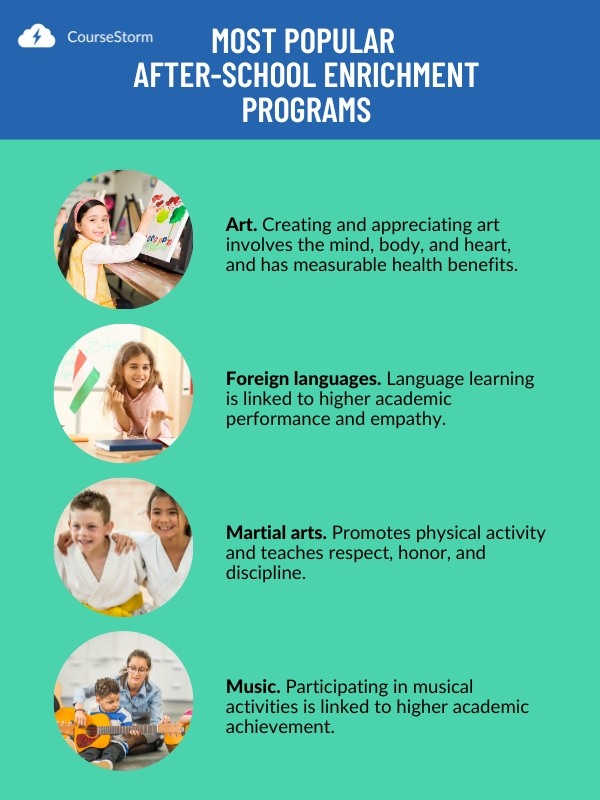
Why Are After-School Programs Important?
Naturally, parents want their children to be safe and supervised after school. There are many benefits to after school programs beyond providing childcare to kids until their parents are done with work, however. In fact, afterschool programs have been shown to improve participants’ performance at school, reduce crime and juvenile delinquency, and provide a significant return on investment through increasing students’ earning potential.
Afterschool programs have been shown to improve school performance, reduce crime, and increase students’ future earning potential.
Data from the Afterschool Alliance, a nonpartisan, nonprofit organization whose mission is to ensure that all children have access to affordable, quality afterschool programs, found the following benefits of afterschool programs:
- Access to caring adults and mentors
- Help children develop social skills and life skills
- Help develop confidence and responsible decision-making
- Reduce the likelihood of children engaging in risky behaviors
- Provide opportunities for physical activity
These findings are more important than ever, given that loneliness and youth mental health issues skyrocketed during the pandemic.
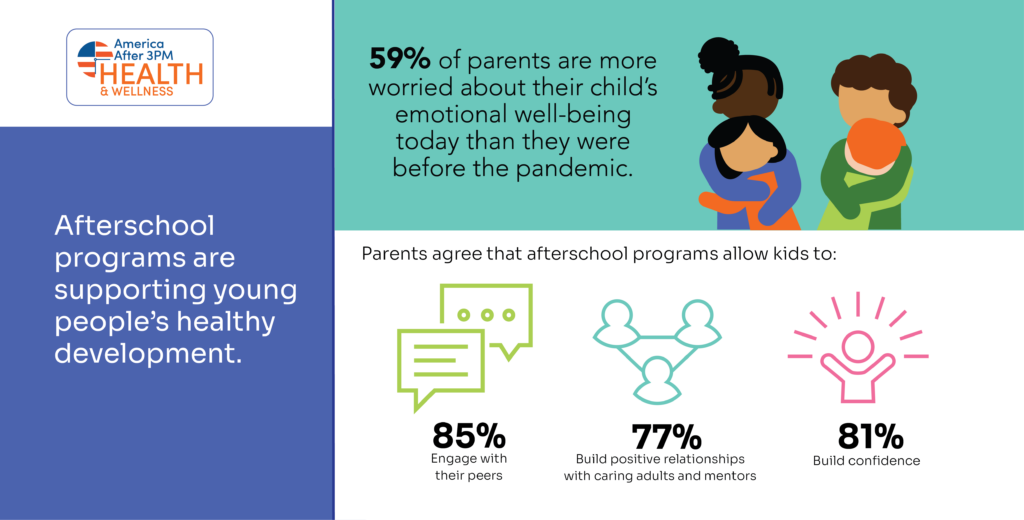
Source: AfterschoolAlliance.org
What Do Parents Look for in Afterschool Enrichment Programs?
To market after-school programs in your community, you first need to understand what’s important to parents and caregivers who will be looking for, evaluating, and ultimately registering their children for afterschool activities.
Transportation may be an issue for many parents if an enrichment program is not at their child’s school, so if your program does or does not include transportation, be sure to note that in your marketing materials and program descriptions.
It’s also a good idea to note whether a snack is included, and if students are given time to complete homework. For some parents, having a place where students can work on assignments and get help if needed is a huge benefit that avoids evening homework battles.
Some community organizations like the Y offer before and after school enrichment programs that start as early as 7 a.m. and are available to students 5 days a week or only 2 or 3 days a week. Perhaps with flexible scheduling, your program could fill a need for parents that other programs don’t.
Demand has skyrocketed: for every child in an afterschool program, three are waiting to get in.
Unmet demand for after-school enrichment programs has skyrocketed. For every child in an afterschool program, three are waiting to get in, according to the Afterschool Alliance. With the right marketing and a simple, parent-friendly registration tool, your afterschool program can be the solution families are looking for.
CourseStorm serves many customers offering after-school activities and enrichment classes. Features like group registration and emailed waiting list invites make for a simple and seamless experience for both families and your program staff. Get in touch with us today for a demo!
-
What’s Your Mindset? Growth vs. Fixed and Why It Matters
As someone who provides educational experiences, you may have heard of the concept of growth vs. fixed mindset. This idea that what you believe about yourself impacts what you can achieve in life is not new. Carol Dweck introduced the concept of growth mindset to the world almost 20 years ago.
Yet knowing is not the same as applying. Even though you model a growth mindset for your students, it’s sometimes difficult to apply it to yourself and your organization. At CourseStorm, we know that growth is a primary goal for many educational organizations. Let’s take a look at how you can apply a growth mindset to help your organization thrive.
What Is a Growth Mindset?
A growth mindset is the belief that you can develop talents and abilities through persistent effort over time. Basically, it says that anyone is capable of improving if they’re willing to work at it.
This is a belief that many educators share. After all, the courses you offer encourage people to work to improve their skills. You don’t assume that a student comes to class already able to do everything you’re going to teach them. What would be the point?
A growth mindset is the belief that anyone is capable of improving if they’re willing to work at it.
Growth mindset stands in contrast to fixed mindset. A fixed mindset is the idea that you are born with a set of abilities or talents and nothing you do can change that.
Carol Dweck explored these two concepts in her book Mindset: The New Psychology of Success which is now considered a pop psychology classic. Yet, many people miss one key idea about mindset, and it’s an idea that’s particularly relevant to organizations.
Dweck says that you may have different mindsets in different situations. For example, you may believe that you are capable of learning anything, but that your level of athleticism is fixed. What does this mean for organizations? It means that even if you have an organization full of educators who believe their students are capable of growth, you may still have a mindset problem when it comes to the organization itself.
The Value of a Growth Mindset for Educational Organizations
“We can’t expect big classes in our small town.”
“We can only offer one class at a time because we can’t handle too many registrations at once.”
“Raising prices would mean we’d lose all of our students.”
All of these are examples of fixed mindset ideas. They assume that the organization’s ability to grow is limited by outside factors. Although context is important, growth-minded organizations don’t assume that a challenge is a barrier. Rather, they look for ways to turn these obstacles into opportunities.
“The growth mindset allows people to value what they’re doing regardless of the outcome. They’re tackling problems, charting new courses, working on important issues.” – Carol Dweck
Organizations with a growth mindset set goals for growth. Fear of failure could hold organizations back from even trying, but growth-minded organizations assume that failure will be part of the process. Just as a student needs practice to develop a skill, organizations may need to try multiple strategies to reach their goals.
What’s Your Mindset? How to Do a Mindset Audit
It’s easy for organizations to fall into a fixed mindset. The burden of responsibility for students and staff members can make leadership more cautious. So can fear of social backlash or a loss of reputation. One fixed mindset person can influence the whole team, especially if that person is in a leadership position.
Avoid the dangers of a fixed mindset by doing an annual Mindset Audit. Gather your leadership together and ask these questions. You can make a copy of our mindset audit form to collect responses.
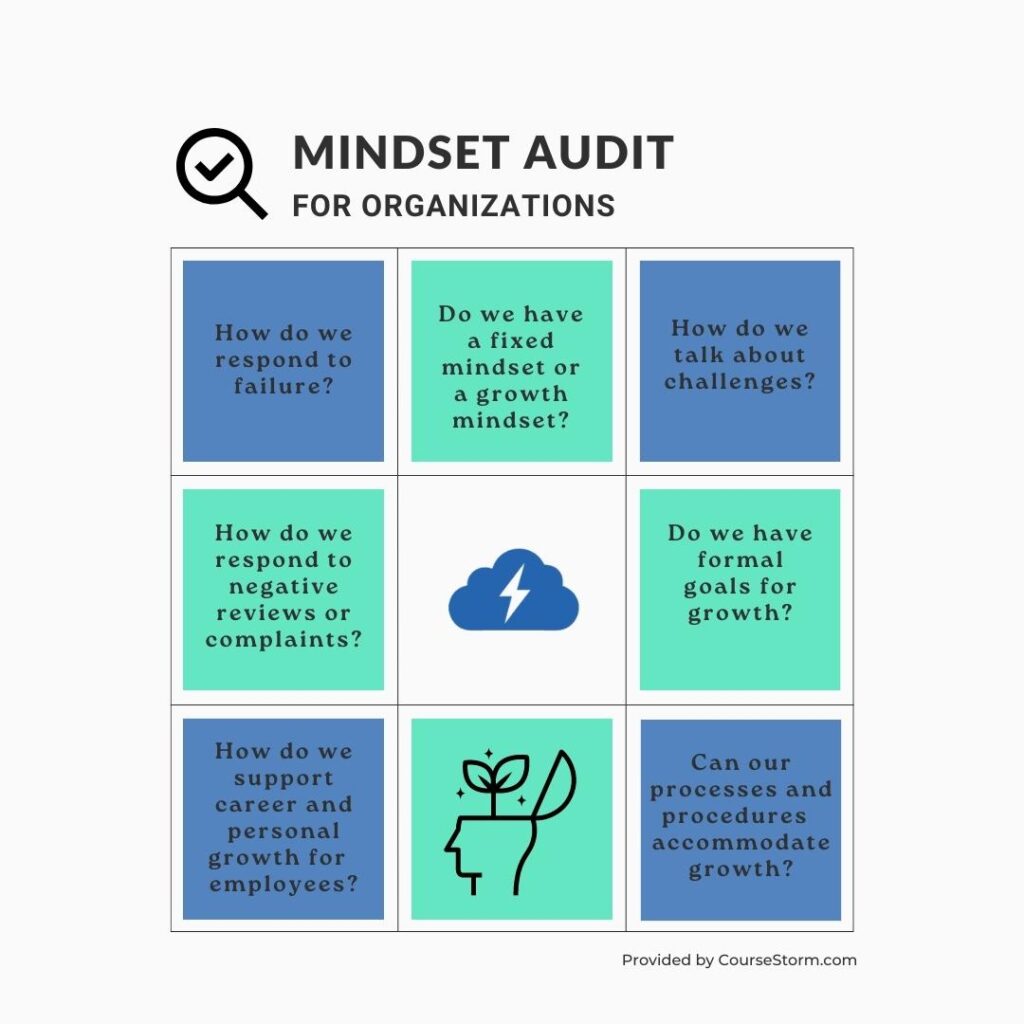
An organization with a growth mindset sees failure as part of the process and uses challenges as opportunities to improve. Negative reviews or student complaints are valuable insights that offer guidance toward improvement. These organizations have clear, trackable goals for growth and support their employees to improve. Finally, they use scalable processes and procedures that leave the organization room to develop.
If you have an open and trusting relationship with instructors and administrative staff, you might ask them variations of these questions as well.
- In your experience, how does our organization respond to failure?
- Without looking anything up, can you list the organization’s formal goals for growth?
- How well do you feel the organization supports your career and personal growth?
- What processes and procedures might limit our growth?
Staff responses can give you insight you might otherwise miss. They help you spot whether your organization is acting on its values.
How to Apply Growth Principles in Your Organization
If you notice your educational organization isn’t as growth-minded as you would like, that’s okay! You can make changes to shift that shared mindset.
1. Create an Organizational Plan for Growth
Consider how you plan to grow and set clear goals for the organization. Keep in mind that organizational growth needs to be sustainable. If you want to add more students, you may need better systems or more staff to meet the workload. To grow revenue, you need more registrations, higher prices, or lower overhead. Think about your goals and what it will take to achieve them. Then, share your plan with the whole organization.
2. Keep Failure in Perspective
Nobody hopes for dissatisfied students, unbalanced budgets, or canceled classes. Yet, these things can happen to any organization, particularly when you try something new like a different type of course or a new software system.
Growth-minded organizations run a post-mortem meeting to figure out what went wrong and learn from it. But they don’t let this learning process feel punitive. The goal is not to avoid failure at all costs, but to learn from it.
3. Support Individual Growth
No matter how skilled your staff members are, they still have room to grow. Your organization can support that growth through periodic performance reviews, training opportunities, and recognizing effort. If possible, you may even provide tuition assistance or fund professional development and attendance at conferences.
4. Plan for Negative Feedback
It’s easy to dismiss negative reviews as the work of internet trolls or unreasonable people. But growth-minded organizations take feedback seriously. They read every review and try to understand how they could do better in the future. That doesn’t mean you take reviews personally, but it does mean thinking critically about the issues raised in a review.
You can also create a process for how staff members should capture and respond to feedback, whether it comes from online review sites or class evaluations.
5. Choose Scalable Solutions
Organizations limit their own growth when they cling to high-effort processes. Although it is possible to manage student registrations with a spreadsheet, that process soon becomes unwieldy. It requires time and effort that might be better spent on directly supporting students.
Scalable processes, procedures, and software solutions give your organization room to grow. Take CourseStorm’s online registration and payment processing software for example.
With no monthly fees, you can scale your organization to meet demand without worrying about the cost of your registration software. Our built-in marketing tools make it easy to reach any group of students or potential students. Plus, automatic waiting lists and low-enrollment warnings help you fill classes and grow your program. For more details on how CourseStorm helps growth-minded education organizations thrive, contact us or download our State of Informal Learning report today.
-
How the Right Enrollment Tool Can Save You Time and Effort
You wouldn’t use a hammer to try to cut a board. Instead, you’d reach for a saw because it’s the right tool for the job. The same is true when you’re registering students for classes. You need an enrollment tool that can get the job done.
Some education providers reach for what’s familiar. They use Excel Surveys or Google Forms to gather information and populate spreadsheets. Those tools are fine if you have plenty of time and energy to spare. Just like a handsaw would be fine if you only had one board to cut.
But if you need to work at volume, you can save time and effort by grabbing a power tool. Just as a circular saw can speed up your carpentry project, CourseStorm’s automated student registration software can streamline enrollments.
What You Need From an Enrollment Tool
You need information to register a student for your class. Most education providers use some sort of form to collect that data. Once you have it, you need to transfer it to your database so you can manage classes and track attendance and payments.
Your enrollment tool should include a registration form and payment processing to create a seamless experience for the student.
Speaking of payments, modern students expect to be able to register and pay entirely online. So your enrollment tool should include both a registration form and a payment processing tool. Ideally, those two are integrated to create a seamless experience for the student.
Course management is challenging enough without having to juggle dozens of paper registration forms and spend hours entering data into a spreadsheet. You certainly don’t want to miss registrations because students have to mail in payment or turn a student away because they haven’t paid by the class date.
While both Excel Surveys and Google Forms can help you collect information, they’re less helpful when it comes to payment processing. Let’s take a closer look at how these tools compare.
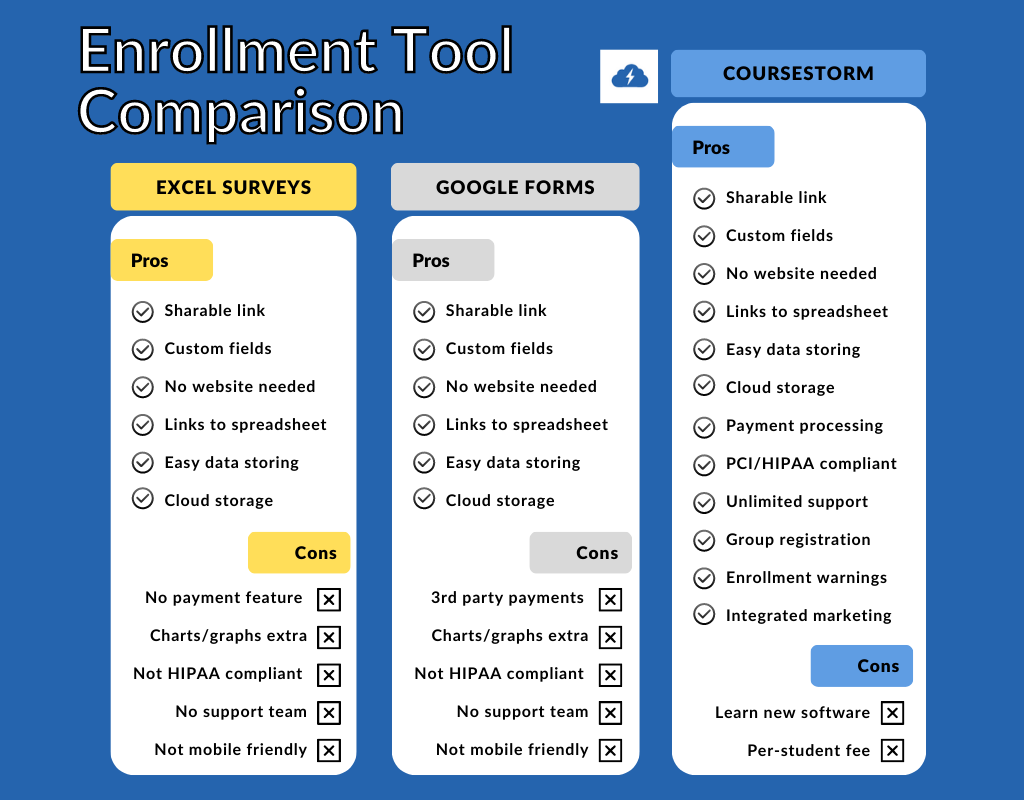
Excel Surveys as Enrollment Tools
Some organizations choose Excel Surveys because they’re already familiar with Excel and feel comfortable with the software. Plus, there’s no extra fee for Surveys if you already use Microsoft 365, which includes Excel.
Basically, organizations create a survey form with question fields. They then share the link to the survey with prospective students. The information automatically fills an Excel spreadsheet as attendees fill out and submit the form.
This all sounds straightforward, but you run into problems when it comes to taking payment. There’s no integrated payment option. So you’ll need to send your students to a third-party site to finish registration, which means you may need to manually match registrations with payments.
Healthcare organizations should be aware that Excel Surveys and Google Forms are not HIPAA compliant, whereas CourseStorm is.
The forms also aren’t very mobile friendly, which can disrupt the student experience. And be careful if you are a healthcare organization subject to HIPAA or other privacy standards. This method is not HIPAA compliant.
Your ability to manipulate the data once you have it will depend on your level of skill with Excel. If you’re already an Excel pro, graphs and reporting might be easy. Everyone else will face a steep learning curve.
Subscriptions to Microsoft 365 start at $8.25 per user per month; discounted plans are available for nonprofits.
Google Forms for Enrollment
Google Forms is another solution you might choose because it’s familiar. Organizations that already use Google for internal email and word processing might try Google Forms for registration. The good news is that Google Forms is somewhat smoother than Excel Surveys and has some added tools that make it easier to manage your registration information.
You still get shareable links, customizable survey fields, and cloud storage. You can also view charts and graphs in real time without any special effort.
Once again, payments are a challenge. You’ll need to link to a third-party payment service. This takes users away from your form and onto another website.
Like Excel, Google is not automatically HIPAA compliant. Organizations that need this level of security may have some extra work to do (and money to spend) to abide by privacy regulations. Access to support is limited and mostly involves community message boards.
Google Forms are part of the Google Workspace suite, which is free for nonprofits and individuals. For-profit businesses pay around $12 per month.
CourseStorm, the Integrated Solution
CourseStorm’s online class registration software is specifically designed to support education businesses by combining registration and payment processes into a single tool. It streamlines the way you handle registration by providing an easy-to-use, customizable, secure, and comprehensive registration and payment system. CourseStorm’s software can integrate with your existing website and connect with Zapier to streamline automations.
The fully customizable registration and payment forms are secure and HIPAA compliant. They keep all of a student’s information together, even offering group registration for families or friends taking classes together.
Before CourseStorm, Westside Christian Academy spent 40+ hours manually pulling data and creating Excel spreadsheets for their summer camp registration.
Westside Christian Academy in Westlake, Ohio, chose CourseStorm to save them time with registration for their summer camps. Last year their executive director spent 40+ hours manually pulling data and creating Excel spreadsheets. She is thrilled to have CourseStorm to make the process easier. “It’s beautiful—it’s like it’s made for me!” she said.
You can share your registration form with parents or students as a link or embed it on your website. Plus, integrated email marketing lets you easily communicate with registrants. Both you and your students get automatic notifications about low and nearly full classes so you can cancel fewer classes. Automatic waiting lists help keep classes full.
All that for no setup or monthly fees—just a small per-student registration fee. CourseStorm is easy to use, but if you do need help, our customer support team is here for you.
Choose the Right Enrollment Tool
Whatever method you choose, automating class enrollment saves your staff time and effort. Students appreciate the easy process and take more classes, and your staff is free to focus on more important things, like growing your program. In fact, CourseStorm customers enjoy an average 18% increase in enrollment the first year, and 15% each consecutive year that they use our impossibly simple class registration software.
Want to see first-hand how CourseStorm automates the registration and payment process? Schedule a demo, or contact us to learn more.
-
How Better Waitlist Management Can Improve the Student Experience
Imagine that you announce a new class and students quickly start signing up. Before you know it, you have more interested students than one instructor can handle. Suddenly waitlist management has become a top priority.
That might sound like a dream come true for your education program, or it may be a regular occurrence. Either way, smart waitlist management can help you make the most of this opportunity. It’s a chance to build a relationship with more students and understand what learners are looking for. We’ll show you how to manage a waiting list without investing in extra waitlist software.
What Waitlist Management Can Do for Your Program
You might wonder if your classes really need waiting lists. It might be easier to just fill classes and not worry about the people who miss out. But with the right tools, managing a waiting list can be simple and having one opens up a number of new opportunities.
With the right tools, managing a waiting list can be simple and opens up a number of new opportunities like these.
1. Keep Learners Engaged
If a potential student learns that a class is full, they may get discouraged. When that discouraging experience is their first interaction with your class offerings, they may go looking for the class in other places. However, a waitlist can keep them engaged a little longer.
Adding students to a waiting list gives them hope that they may still get to register. They’re likely to be extra engaged as they wait for news. This engagement creates an opportunity for you to reach out with other options—classes that meet at a different time or cover related topics. You might even provide a promo code they can apply to another class while they’re waiting.
2. Improve the Student Experience
A student who ends up on a waiting list is likely to be disappointed, but they also gain something valuable—early access to registration for upcoming classes. Students on your waiting list should get the chance to register before the general public. While the timing may not work out for them, you’ve at least shown the student you care about their experience.
3. Fill Classes Faster
Waiting lists help you fill classes faster by preloading the class with waiting list students. Other potential students may be spurred to action by the knowledge that the class is filling up fast. This can create a positive feedback loop that leads to even more interest in the class.
4. Help You Plan Your Course Calendar
A waiting list is a good indication that people are interested in the topic you’re teaching. You may choose to add a second session or create other classes around the topic. It might even be worthwhile to move resources away from a low-enrollment class so you can offer more sessions of high interest classes.
5. Influence Your Pricing Strategy
If a class regularly has a waitlist, you may also have room to increase your prices. Students are often willing to pay more for a class they see as popular and highly valuable.
How to Manage a Waitlist
Managing a waitlist can be simple if you have the right processes in place. An online registration system that includes a waitlist option (like CourseStorm) is the easiest way to manage your waitlists. You can enter the data into a spreadsheet or even a paper form, but the more you can automate the process, the easier it will be.
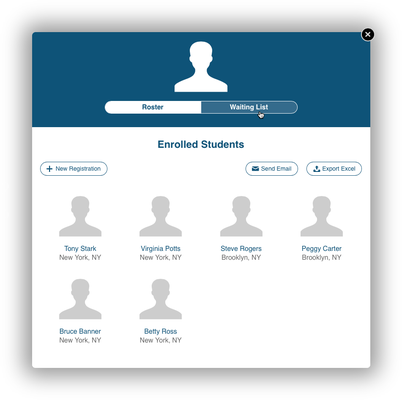
Here are a few more tips to improve your waitlist management:
- Tag everyone on your waiting list with the class and class category they’re interested in, so you can contact them with relevant opportunities.
- Try CourseStorm’s new waiting list feature: when a spot becomes available, you can send people on the waiting list a link that expires after a set time. Then, they can either register right on your site or decline the invite.
- Have a clear waitlist policy so potential students understand what they’re signing up for.
If you don’t already have a waitlist policy, that last tip may require some explanation. Here’s what should go in a waitlist policy and how to share one.
Write a Waitlist Policy
Let students know how you’ll manage your waitlist by including a clear waitlist policy when they join. Students should understand exactly what they’ll get out of joining the waitlist and how you’ll communicate with them about upcoming opportunities.
Every waitlist policy should cover these 3 things. We’ve suggested some sample language to use.
Even a simple first-come-first served policy needs some explanation. Every waitlist policy should cover:
- How you’ll communicate with people on the list.
- What they get out of joining the list.
- How potential students can remove themselves from the list.
Here is some sample language you might include in your waiting list policy:
- “If a space opens up in the class you are interested in, you will be notified by email. You will have 24 hours to either complete your registration or decline the opportunity. If you have not completed your registration within 24-hours, we will assume you have declined and will offer the space to the next student on the list.”
- “If space does not open up in the class you are interested in, you will get early registration access to the next class session. Please watch your email for notifications.”
- “We may email you with recommendations for upcoming classes related to this one. Please watch your email or visit our course catalog for more details.”
- “If you would like to remove yourself from this list, please email: registrations@myurl.org. It may take up to 48 hours to remove you from our system.”
If your waiting list policy is anything other than first-come-first serve, note that in the policy. For example, you may give preference to people who have relatives already in the class, are members of your organization, or have taken classes with you in the past.
Waitlist Management Made Simple
Having a waitlist for your classes provides an excellent customer experience, can make your program more successful, and helps you fill classes. You can automate waitlist management by including the option for every class you offer. Learn how to build a waitlist in CourseStorm or contact us for more details.
-
6 Benefits of Enrichment Classes for All Ages
Education doesn’t stop when the school bell rings or when graduation is over. In fact, everyone is constantly learning, whether that’s through a formal class or informal exploration. People who take a lifelong learning approach to life may seek out enrichment classes for personal growth, to build new skills, or connect with others in their community.
What are enrichment classes? Typically non-credit, they can cater to any age or interest of learners in your local community.
What are enrichment classes? Afterschool programs, adult ed classes, workshops at your local makerspace, lectures at a senior center, and educational offerings at a theater or museum can all be considered enrichment programs. Enrichment classes are non-credit and typically outside of core subjects like math and reading. They can cater to any age or interest; the common theme is that the majority of learners come from the local community.
Below, we explore 6 benefits of enrichment classes that community education programs can use in their marketing campaigns, to encourage donations, or to inspire your team by reminding them that they’re doing important work.
Benefits of Enrichment Programs for Your Community
Are you wondering why is enrichment important for students? Enrichment classes fill needs that for-credit courses and other educational programming just can’t. Enrichment classes also strengthen your community and your organization’s place within it. Here are 6 ways enrichment classes benefit learners and communities.
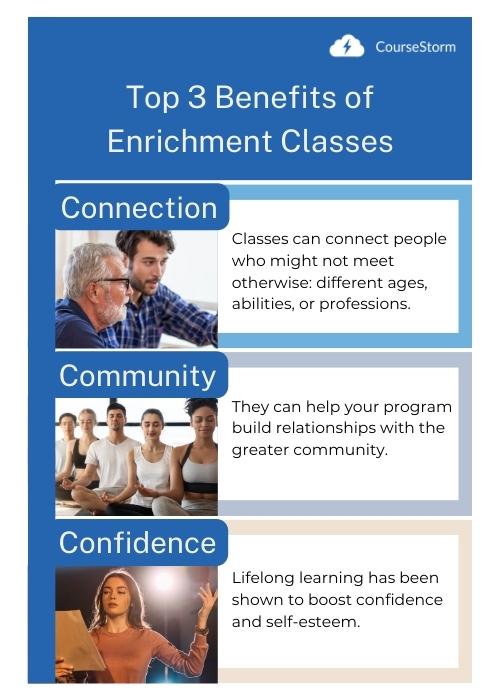
1. Connect people who might not meet otherwise
Enrichment classes have an amazing way of bringing people together. They might be students with different majors who would never cross paths otherwise, or they could be members of your wider community who work in different areas. Bringing these people together enriches everyone. It leads to lateral thinking, unconventional partnerships, and a sense of community connection.
An innovative program at the University of Texas at Austin called Lifelong Learning With Friends gives adult learners with intellectual and developmental disabilities access to the university experience through stimulating and fun post-secondary education opportunities. “Reverse inclusion” means that neurotypical UT college students learn alongside their neurodiverse peers.
2. Claim your place within a wider community
Enrichment classes also help your program build relationships with the wider community. When people in the community depend on your program as a source of education, they have tangible examples of the value you offer to the community. This makes them more likely to support, donate, and lobby on your behalf.
Many community colleges have begun offering non-degree credentials that address the needs of local employers and industries. Forming partnerships with local businesses is a win everyone: the educational institution, learners, and the community.
3. Improve soft skills and confidence
Many learners are focused on how education can help them find a new job or earn a raise in their current one. But technical classes aren’t the only way to do that. Enrichment courses help learners improve soft skills. From creativity to communication, problem-solving to public speaking, enrichment classes present fun challenges that help learners improve their skills.
Lifelong learning has been shown to boost confidence and build soft skills like creativity and communication.
Learners don’t leave these skills in the classroom. They bring them out into the community. Plus, lifelong learning has been shown to boost confidence and self-esteem. It also gives people hope and purpose, which can help them face the stressors of life.
4. Prevent the dreaded “brain drain”
Enrichment classes can keep kids from backsliding during summer breaks. Research has shown that kids can lose an average of 20-27% of their school-year gains during summer vacation. Keeping them engaged and learning can help prevent some of these losses.
The same principle can help seniors in retirement. Research has shown that seniors can improve their cognitive health by learning something new. It’s more effective than just socializing. So your enrichment program can benefit both the oldest and youngest members of your community.
5. Give every learner the chance to shine
Traditional academic subjects may not be everyone’s idea of a good time. Students who struggle with math or reading may excel in classes focused on arts or performance. Those who hate sitting through a whole class period may blossom in a dance or gymnastics class. Offering a variety of types of classes invites more people into your learning community. Encouraging a more diverse community benefits everyone.
To get a better understanding of the different kinds of learning and where your program fits in, check out our free resource, A Complete Guide to Types of Learning and Why We Need Them All.
6. Bring in new students and keep existing students engaged
If your organization offers for-credit courses or diplomas, enrichment classes can serve as a lead magnet for these higher-investment programs. They give students a fun and accessible way to experience your program. Even offering a free course can pay off in the long run.
Offering enrichment classes can keep students engaged and attract new learners between sessions or semesters of for-credit courses.
Engagement leads to enrollment. If your organization offers semester-based learning or seasonal programs, you probably experience some enrollment melt between sessions. Offering enrichment classes can keep students engaged during the off-season so they’re more likely to re-enroll during the regular term.
Use These Benefits of Enrichment Classes in Marketing
Knowing the benefits of enrichment classes is one thing. Spreading the word about them is another. Help learners and community members see the value of your program by talking about these benefits. Not only could it help you sell more classes, it can also show your commitment to the community.
Of course, none of the benefits of enrichment classes can be realized until students enroll. Make registering for your enrichment classes easy with our impossibly simple registration software. We offer everything you need to register students, manage class rosters, and keep students engaged with your program. Start your free trial or contact us today.
-
How Value-Based Selling Can Help You Register More Students
Most people don’t get into the education industry because they love selling things. Yet, selling your courses to students is an important part of your job. Think of it this way: students need to register for your courses before they can benefit from them. Because you care about students and want to help them, value-based selling may be a great fit for your organization.
Value-based marketing and selling puts the student and their needs at the core of your sales efforts. It encourages you to work with students to help them find the right learning experience for them. Along the way, a value-based selling methodology can help you register more students. Let’s explore how you can put this strategy to work for your program.
What Is Value-Based Selling?
Value-based selling is an approach to marketing and sales that focuses on creating value to the customer. For programs that provide learning opportunities, this starts with adopting a student focus. You should understand what students gain by taking your classes and find ways to offer value before, during, and after registration.
Value refers to the worth or usefulness of something. A class can offer quantitative value (earning a credential), or qualitative value (improving quality of life).
Value can be a slippery term, but basically, it refers to the worth or usefulness of something. Some products and services have quantitative value — they can help customers save or earn money. Unless you’re teaching workforce development classes, quantitative value might be hard to prove for your courses.
Most enrichment and personal development classes offer qualitative value — they improve quality of life for the student.
Examples of Qualitative Value Offered by Enrichment Classes:
- Increased confidence
- Improved wellbeing
- Stronger social ties and sense of community
- Greater cultural awareness
- Better physical or mental health
- Deeper self-awareness through self-discovery
- Higher emotional intelligence
- Fun and entertainment
- More resilience and grit
Use the qualitative value of your classes to find your unique value proposition.
How to Identify Your Unique Value Proposition
Students have more types of learning opportunities to choose from than ever before. They can take classes in-person, online or both. They can choose a college, school, organization or private instructor. Free resources like YouTube and public libraries make self-study an attractive option.
Your unique value proposition is what makes your classes different from your competitors’.
Your unique value proposition makes the case for why a student should choose the classes you offer. It’s an essential part of your program or organizational branding.
Here are a few places to start looking for your unique value proposition:
- Small class size
- Personalized approach
- Unique focus or specialty
- Award-winning instructors
- Partnership with a local organization or employer
- Ongoing support
- Robust student community
- Expertise in a particular student population
Maybe yours is the only program that offers in-person classes on this subject in your town. Perhaps you have special expertise in working with teens, or have a certification in trauma-informed instruction. Anything that sets you apart can form part of your unique value proposition.
Just keep in mind that something only adds value if students need or can use it. If you primarily teach adults, having a staff member with a Ph.D. in child psychology may not add value. Unless, of course, you decide to add parenting classes to your course catalog.
Sometimes what looks like a drawback can actually add value if framed in the right way for the right audience. Being the only dance studio in town without mirrors on the wall might not add value. Unless your program embraces body positivity and believes that dance is about how you feel, not what you look like.
Build a Value Selling Framework Around the Student
The trick is to identify your ideal student and research the needs that student is likely to have. Then you can create marketing materials, courses, and support systems that provide value for that student.
The danger in this approach is that you’ll fall back on stereotypes. Instead of guessing at what your students want, research what they actually need. Listen to their complaints and concerns and ask them about their goals.
Here’s an example: You may know that your average student is a 30-55 year old woman. She is likely either married or divorced and has 2-3 children. She has a full-time job and a family income of around $80,000 per year. She lives in town and has her own vehicle.
With this information, you can make some guesses or assumptions about what this student might value:
- Price may not be a major concern for her. So you might choose not to focus on cost savings.
- You might assume she would prefer evening classes she can attend after work.
- With her busy lifestyle and many commitments, she might not have much time for building social connections. Maybe she would value opportunities for relationship building and community connection.
The best way to check these assumptions is to ask. You can use student feedback forms or course evaluations to ask questions like:
- What do you value most about this class?
- How will you use what you learned here in your everyday life?
- To whom would you be most likely to recommend this class?
- How could we improve this class?
How to Apply a Value-Based Selling Approach
Most of the articles you’ll read about value-based selling focus on how sales teams can use it in conversations with customers. However, many of your students will register online without ever speaking to a member of your team. In that case, a completely personalized sales strategy may not be realistic. You have to rely on value-based marketing, instead.
Value-based selling relies on conversations with customers; if students are registering online on their own, you’ll need to focus on value-based marketing.
Here are a few ways to apply a value selling methodology across your marketing and sales platforms.
Value-Based Marketing on Your Website
When creating your website, look for opportunities to communicate your unique value proposition. Make sure your homepage and about us page explain the unique value you offer students.
- Instead of: We teach painting, photography, and drawing to students of all ages.
- Say: We help students of all ages develop their artistic skills and realize their creative vision through painting, photography, and drawing classes.
If you have a blog, offer useful advice and lessons, rather than focusing on your courses and program. Sharing this type of information helps build trust with students.
Including Value in Course Catalogs
Write class descriptions that highlight the value of each class or offering in your course catalog. Paint a picture of the results a student can expect from the course. Here’s an example from a sailing class:
Deepen your knowledge of sailing and build fundamental skills, while developing appreciation for the sea and its mysteries. Join a community of like-minded adult sailors, ready to embark on new voyages and share tales of the open water. Together we’ll explore essential sailing terminology, equipment, and safety, as well as boat handling and reading nautical charts. Whether you dream of leisurely cruises or competitive regattas, this course will help you launch an unforgettable sailing adventure.
This example tells the student what they will learn, but also highlights the qualitative value of the course. It promises community and skills, and implies that students will come away with stories worth sharing.
Value-Based Messaging on Social Media
Your social media posts should also focus on value, but they need to get to the point more quickly. You can use them to announce a class, but also to share valuable content that students might be interested in.
Consider mixing up your social media feed with:
- Industry news
- How-to content
- Polls and open-ended questions
- Creative prompts
- Fun facts
All of these types of content offer value to students. They can also increase engagement, which helps more people see your posts.
Targeted Email Marketing
Email marketing allows you to provide value by offering the exact classes a particular student may be looking for. You can predict that a student who has finished the beginner’s class might be interested in the intermediate one. A student who took a class in post-Impressionist painting styles might also be interested in a class on Expressionism.
With CourseStorm, you can automate marketing emails. Our automated email system offers recommendations based on the classes students have taken before. Our streamlined platform simplifies the class registration and payment process, which saves your students time. With no monthly fees, you only pay when you actually register a student.
Start your free trial of CourseStorm today or contact us for more information!

